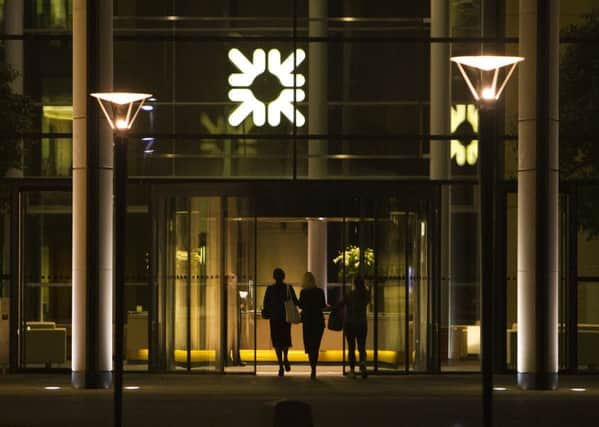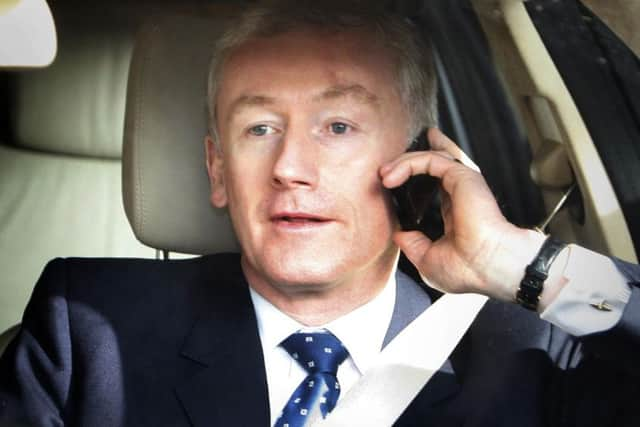Insight: How I watched the RBS debacle unfold


Readers were frantic with worry. As well they had cause to be as shares in Scotland’s largest banks – so recently impregnable, so seemingly too big to fail – had gone into freefall.
“Hello! Should I switch out of RBS?” “Hello! What’s happening to my savings?” “Hello! Am I safer with HBOS?” “Hello! When’s this all going to end?”
Advertisement
Hide AdAdvertisement
Hide AdAs if I knew. As if anyone knew in that crazy, panicky, febrile time and in this mad, stomach-churning plunge. For those who had their savings in RBS or HBOS, that week was akin to being trapped in a plunging lift with no brakes.


On my PC screen at The Scotsman I had contrived to have a stock market ticker gadget running along the bottom. For days the prices of leading shares had been forming a constant ribbon of red, an incarnadine, blood-gushing wound beyond healing.
But it wasn’t just the colour of blood. It was the magnitude of the falls: RBS down 30 per cent, HBOS down 23 per cent. Not over a month, or a week, or even a day, but within a few minutes.
On the morning of 6 October shares in RBS had crashed 50 per cent at one point. Shares in other banks were also tumbling amid denials that they were seeking emergency support from the Bank of England.
Briing, Briing! Now it was my turn to hit the phone. I rang the RBS press office, desperate to lift the siege of official silence that had descended on the banking sector.
Briing, Briing! For the first time I could recall – no reply. Normally I would be given a polite “no comment”, or, if I was lucky, a stream of blistering imprecations from the bank’s communications chief, Howard Moody.
Throughout the day there was pandemonium in the markets – and across Scotland’s financial sector there was barely a single person who knew what was going on, trapped helplessly in their bunkers as events in the market put on a display of sickening fireworks.
At 3pm The Scotsman’s news executives assembled in the editor’s room for afternoon conference. Nick Bevens, our business editor, opened with the startling news that shares in RBS had plunged – yet again.
Advertisement
Hide AdAdvertisement
Hide AdBut barely had this announcement sunk in than Scott Reid, his deputy, shot in with a breathless announcement: “RBS! The shares have bounded back up! They’re only down 25 per cent!”
Editor Mike Gilson held his head in his hands. “Can’t you guys make your mind up? I bet you by the time Scott gets back to his desk the shares will be back on the floor!”
Did the editor have a front page splash – or just another day of turmoil in the markets? What in any other period would have been extraordinary was now down-the-page commonplace.
Briing, Briing! I’m back on the phone. When seeking information on a company, it’s often worthwhile to ring its rival. So, I put in a call to Bank of Scotland’s Investment Services arm. I asked to speak to the manager, whom I knew well.
There was a silence, before a female voice replied with a slight tremor, “He’s not in today.”
“Not in? Where’s he gone?”
“He’s left the company.”
Stunned silence. Since I had only spoken with him a few days earlier, that was a shock.
“So, who’s taken his place?”
There was a pause on the line and some incoherent mumbling.
“Er, I have,” came the reply. “But I’m leaving too.”
I couldn’t help but think of all the hundreds of customers whose savings were being looked after by the bank – but just when “looking after” really mattered, the managers had fled. But in the bizarre, cack-handed world that financial regulation had often become, the customers could not be told that their account managers had gone because regulations forbade departing staff from communicating with their former clients.
Advertisement
Hide AdAdvertisement
Hide AdAnd this amid a market crash and a deafening silence of explanation as to what was going on. Those empowered to speak didn’t know. And those who did know couldn’t speak.
It seemed only yesterday that RBS had been congratulating itself on the takeover of Dutch banking giant ABN Amro.
And it seemed only the day before that I was in the RBS dining room at 36 St Andrew Square as Sir Fred Goodwin held forth to a group of business journalists on the joys of Formula 1 racing. For the life of me I couldn’t understand why that was a worthwhile topic of conversation. But then I didn’t know Goodwin well enough to appreciate that he thought it so.
RBS at the time was a hurricane in motion. It had racked up a flawless series of acquisitions, fired by the success of the National Westminster take-over in early 2000. This was a bank that could only go up, and whose achievements were an immense source of Scottish pride, its press releases comparing its global presence with that of Coca-Cola.
But with ABN Amro the cracks began to show. The share price began to limp. It was always ironic that rival bidder Barclays lost because its offer, largely comprising Barclays shares, failed as the value of its paper weakened in the closing days. Weak paper? RBS was about to show the world how weak a company’s paper could be.
It’s often said that the RBS share price plunge began with the collapse of US investment banking giant Lehman Brothers, which filed for America’s biggest bankruptcy on 15 September. But in truth the alarm bells were ringing long before – and were particularly loud on 22 May when the shares plunged just ahead of the £12 billion rights issue completion.
How irresistible that offer of shares at 200p apiece seemed to many. Almost all the contacts I had in Scotland’s financial services sector had subscribed, unshakeable in the belief that RBS shares could fall no lower. But fall they did.
Several weeks before the balloon went up for HBOS I remember standing at a corporate buffet lunch in Edinburgh overhearing a senior female lawyer pronouncing with certainty that HBOS was “as good as gone”. Such was the mood of shock at the time that this statement was greeted with almost fateful resignation.
Advertisement
Hide AdAdvertisement
Hide AdRoll on 6 October, the Day of Reckoning before the government rescue plan was unveiled and amid the mayhem I had still been hoping that there would be a last-minute miraculous bounce-back across the market. I remembered my first experience of a market collapse – in the winter of 1974 when the FT30, the popular barometer at the time, had plunged 96 per cent. National Westminster Bank had to resort to a desperate rearguard action to quash rumours that it was about to go bust. But then on 6 January, 1975, out of nowhere, the market bounded upwards. That day I looked down at the Stock Exchange floor trying to work out what exactly had happened and why. A buying conspiracy by the institutions? We could only surmise.
No such dramatic bounce was to save RBS. Instead, I was told that on the 5 and 6 October dozens of household name financial institutions and pension funds had flung their RBS holdings into the market fire, a collective surge of “sell” with which the Stock Exchange could barely cope. RBS had been one of the most widely held shares. Now we were witness to a mighty bonfire of near worthless paper.
There’s rarely much to see in a stock market crash. The buildings don’t burn and there’s no dramatic scenes of crumbing masonry. But there is no doubt that on 7 October, 2008, the edifice of RBS had been blackened for a generation.
On one afternoon of that fateful week I was standing outside the head office of Bank of Scotland on the Mound. Every so often bank officials popped out to check whether queues were forming of customers anxious to withdraw cash.
For that was how close we got, not just to a banking collapse, or an economic seizure but something altogether worse – the onset of panic as the ATMs stopped coughing out money. Social breakdown would have been widespread, violent, and ugly.
Tens of thousands of investors lost out, as did thousands of bank staff. Next to the slaughter were tens of thousands of small businesses where overdraft facilities were suddenly withdrawn and loans called in. The psychological trauma, as much as the financial loss, was profound.
I could not imagine then how we could recover, still less how Scotland’s capital city could absorb the loss of thousands of jobs and livelihoods. But a year later I filed a front page story as improbable as the crisis that had struck. It was about the record numbers at the Edinburgh Festival, the crowded streets, packed restaurants, the hotels full to bursting and a rise in business birth rates. “Resilient Edinburgh” was the headline.
I have scrapped the market ticker on my office PC. But the phones? Briing, Briing! There’s just no stopping them.